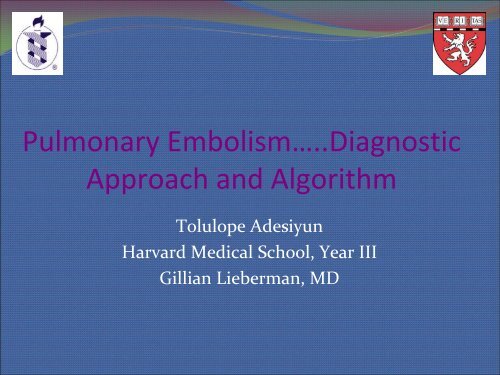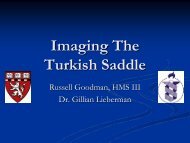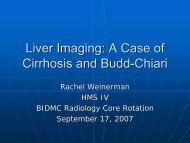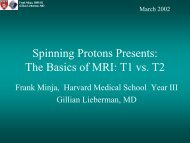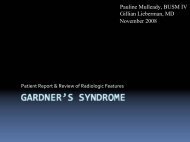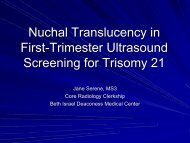Pulmonary Embolism: Diagnostic Approach and Algorithm
Pulmonary Embolism: Diagnostic Approach and Algorithm
Pulmonary Embolism: Diagnostic Approach and Algorithm
Create successful ePaper yourself
Turn your PDF publications into a flip-book with our unique Google optimized e-Paper software.
<strong>Pulmonary</strong> <strong>Embolism</strong>…..<strong>Diagnostic</strong><br />
<strong>Approach</strong> <strong>and</strong> <strong>Algorithm</strong><br />
Tolulope<br />
Adesiyun<br />
Harvard Medical School, Year III<br />
Gillian Lieberman, MD
Epidemiology of <strong>Pulmonary</strong> <strong>Embolism</strong><br />
<strong>Pulmonary</strong> Embolus (PE): Thrombus originating<br />
in the venous system that embolizes to the<br />
pulmonary arterial circulation<br />
PE occurs in up to 50% of patients with proximal<br />
DVT <strong>and</strong> about 79% of patients with a PE have<br />
evidence of a DVT<br />
600,000 episodes yearly in United States<br />
100,000 to 200,000 deaths<br />
Untreated PE = mortality of 15–30%.
Pathophysiology of PE<br />
In Acute PE:<br />
Anatomical obstruction <strong>and</strong> release of<br />
vasoactive <strong>and</strong> bronchoactive agents e.g.<br />
serotonin from platelets contribute to<br />
development of ventilation–perfusion<br />
mismatching<br />
Increased pulmonary vascular pressure<br />
Right ventricular after load increases tension<br />
in the right ventricular wall rises <strong>and</strong> may lead<br />
to dilatation, dysfunction, <strong>and</strong> ischemia of the<br />
RV
Diagrammatic Depiction of PE Pathophysiology<br />
Tapson V.F. Acute pulmonary embolism. N Engl J Med. 2008 :358:1037-52.<br />
• Origin: Deep veins, most<br />
commonly the calf veins<br />
• Develop in places of venous<br />
stasis e.g. venous valve<br />
pockets of lower extremity<br />
veins<br />
• Risk of embolism is increased<br />
if clot propagates to or<br />
originates in popliteal veins<br />
or more proximally<br />
• Thrombi travel to right side<br />
of heart then to pulmonary<br />
arteries
Risk factors<br />
Thrombosis<br />
Virchow’s Triad:<br />
for Deep Vein<br />
Endothelial Injury: Trauma, surgery<br />
Stasis: Inactivity/ Immobility<br />
Hypercoagulability:<br />
‐<br />
‐<br />
Inherited: Protein C or S deficiencies, Anti ‐<br />
phospholipid syndrome, Factor V Leiden<br />
mutation, Prothrombin gene mutation<br />
Acquired: Pregnancy, Malignancy, OCPs,<br />
Smoking
Clinical Symptoms of PE (PIOPED II study)<br />
Clinical symptoms suggestive of PE:<br />
Dyspnea<br />
Chest pain (Pleuritic or non pleuritic)<br />
Cough<br />
Orthopnea<br />
Calf <strong>and</strong>/or thigh pain or swelling<br />
Wheezing<br />
Common signs:<br />
Tachypnea<br />
Tachycardia<br />
Rales<br />
Decreased breath sounds<br />
Jugular venous distension<br />
Accentuated pulmonic component of second heart sound<br />
Symptoms/ signs of lower extremity DVT include edema, erythema,<br />
tenderness or a palpable cord.
Menu of Tests<br />
Chest X‐Ray (CXR)<br />
ECG <strong>and</strong> D‐Dimer<br />
Computed Tomography: Multiple detector CT<br />
pulmonary angiography (MDCT‐PA)<br />
Ventilation‐ Perfusion Scan<br />
<strong>Pulmonary</strong> Arteriography<br />
MRI<br />
ECHO (not used for diagnosis)<br />
Imaging Lower Extremities:<br />
Ultrasound
Step one in evaluation: CXR<br />
CXR is always the first imaging modality to obtain when<br />
evaluating a patient with chest pain<br />
CXR often not diagnostic<br />
Non specific findings that may be present:<br />
Cardiac enlargement, pleural effusions, elevated<br />
hemidiaphragm, pulmonary artery enlargement, discoid<br />
atelectasis<br />
Classic Findings on CXR:<br />
‐<br />
‐<br />
Westermark Sign<br />
Hampton’s hump
Companion Patient #1: CXR with Discoid Atelectasis<br />
PACS, BIDMC<br />
Frontal CXR: Boxes indicate areas of discoid atelectasis<br />
CXR in a patient with a<br />
PE showing some areas<br />
of discoid atelectasis<br />
This does not rule in or<br />
rule out a PE<br />
Remember: A normal<br />
CXR never rules out a<br />
PE!
Companion Patient #2: Westermark Sign on CXR<br />
http://www.e-radiography.net/technique/chest/cxreval22.jpg<br />
Watermark Sign: Dilatation<br />
of pulmonary vessels<br />
proximal to embolism along<br />
with collapse of distal<br />
vessels, often with a<br />
sharp cut off as shown by<br />
white arrow.<br />
Frontal CXR: Arrow indicates<br />
abrupt cut off in pulmonary<br />
vasculature
http://www.imagingpathways.health.wa.gov.au/includes/images/pe/ham.jpg<br />
Hapmton’s Hump:<br />
Peripheral wedge shaped<br />
opacity representing<br />
pulmonary infarction <strong>and</strong><br />
atelectasis secondary to a<br />
pulmonary embolus as<br />
shown by white arrow<br />
Frontal CXR: Arrow indicates<br />
Wedge shaped infarct
ECG: Not specific<br />
Tachycardia<br />
Axis deviation<br />
Right bundle branch block<br />
S1Q3T3 pattern<br />
D‐Dimer:<br />
ECG <strong>and</strong> D‐Dimer<br />
Good sensitivity but poor specificity<br />
Best to use this in conjunction with clinical probability.
We have discussed the preliminary tests that<br />
are usually obtained in evaluating a patient<br />
with a PE. Now we will discuss the main<br />
diagnostic imaging modalities for PE.
Preferred <strong>Diagnostic</strong> Modality Today: MDCT‐PA<br />
Contrast enhanced MDCT –PA is currently the<br />
preferred method of diagnosis<br />
Sensitivity (83%) <strong>and</strong> specificity (96%) of MDCT‐PA for<br />
the detection of PE (PIOPED II)<br />
Typical findings on CTPA include:<br />
‐ Complete arterial occlusion: Low attenuation on CT<br />
‐ Non obstructive intraluminal filling defects<br />
‐ Evidence of right heart strain<br />
‐ Polo mint sign <strong>and</strong> Rail track sign<br />
‐ Can see peripheral wedge shaped infarcts
We will see images of the CT<br />
findings of PE later, when we<br />
discuss our index patient MH.
Advantages <strong>and</strong> Disadvantages of CTA<br />
Advantages:<br />
Readily available<br />
Fast<br />
Minimally invasive<br />
Can provide prognostic information by assessing the size of<br />
the right ventricle<br />
Can detect alternative diagnoses<br />
Disadvantages of CTA:<br />
Expensive<br />
Radiation dose<br />
Contraindicated in those with renal failure, contrast allergies<br />
<strong>and</strong> pregnant women
Why Should We Take Non Contrast<br />
Images When Performing a CT?<br />
To rule out other pathologies such as Intramural<br />
Hematomas which would not be well visualized on<br />
contrast enhanced images.<br />
Remember the radiologist is responsible for ruling out<br />
other possible etiologies of the patient’s symptoms<br />
<strong>and</strong> not just a PE.
Before CTAs became so popular<br />
VQ scans were in vogue.
Ventilation Perfusion (VQ) Scan<br />
Non invasive nuclear study: Identifies areas of<br />
VQ mismatch indicative of a PE<br />
Scans categorized as high, intermediate, low,<br />
very low probability or normal<br />
Largely replaced by CT but is still useful in<br />
situations where CT is contraindicated as<br />
previously mentioned
Technique <strong>and</strong> Limitations of VQ Scans<br />
CXR used as adjunct in interpretation<br />
Ventilation phase: Radioactive gas, usually xenon, is<br />
inhaled by patient. Normal scan would show<br />
homogenous bilateral distribution of the tracer<br />
Perfusion phase: Clusters of human albumin with a<br />
radioactive particle are injected into the patient’s vein.<br />
Normal scan would show homogenous bilateral<br />
distribution of tracer<br />
Limitations:<br />
‐ Many scans are indeterminate <strong>and</strong> thus non diagnostic.<br />
‐ Difficult to interpret in patients with certain underlying<br />
lung diseases e.g. COPD
Companion Patient #4 with Abnormal VQ scan<br />
http://www.imagingpathways.health.wa.gov.au/includes/images/pe/vq.jpg<br />
VQ scan: Purple circles indicate areas of decreased perfusion<br />
The ventilation series<br />
demonstrates uniform<br />
distribution of tracer<br />
throughout both lung fields.<br />
Generalized reduced trace<br />
uptake seen in the right lung<br />
Multiple segmental <strong>and</strong><br />
sub segmental perfusion<br />
defects throughout both lung<br />
fields.<br />
These findings have a high<br />
probability for recent<br />
pulmonary embolism.
Less Frequently Used Imaging Modalities:<br />
<strong>Pulmonary</strong> Angiography: Previously gold st<strong>and</strong>ard for<br />
diagnosing of acute PE, no longer in common use due<br />
to advances in CT <strong>and</strong> invasive nature of angiography<br />
MR Angiogram: Non invasive, but takes longer to<br />
perform <strong>and</strong> more technically challenging<br />
ECHO is not used for diagnosis but can show<br />
evidence of heart strain such as RV enlargement or<br />
ventricular dysfunction
As previously mentioned lower extremity<br />
ultrasounds are used to evaluate for clots in the<br />
lower extremity. We will now see examples of a<br />
normal ultrasound <strong>and</strong> an abnormal one.
Companion Patient #5: Normal Left Common<br />
Femoral Vein<br />
PACS, BIDMC<br />
Lower Extremity Ultrasound: Arrow indicates compressed femoral vein
PACS, BIDMC<br />
Companion Patient # 6: Non Compressible Left<br />
Popliteal Vein with DVT<br />
Lower Extremity Ultrasound: Purple star shows non compressed popliteal vein
Companion Patient # 6: Lack of Flow in Left Popliteal<br />
Vein Filled With Clot<br />
PACS, BIDMC<br />
Doppler Ultrasound: Star<br />
indicates lack of flow in<br />
popliteal vein secondary to<br />
obstruction by clot
Interim Summary<br />
We have spoken about the pathophysiology <strong>and</strong><br />
presentation of pulmonary embolism<br />
We have discussed the menu of tests at our disposal<br />
to guide our diagnosis<br />
We have seen examples of CXR, VQ scan <strong>and</strong> lower<br />
extremity ultrasound findings of PE <strong>and</strong> DVT<br />
We will now discuss our index patient MH <strong>and</strong> view<br />
examples of the CT findings that accompany PEs
Index Patient MH<br />
HPI: 47 yo F with a history of left upper arm DVT who was on a recent flight.<br />
She presented to the ED with complaints of sudden worsening of her<br />
baseline tachypnea <strong>and</strong> pleuritic chest pain.<br />
PMH: History of Left UE DVT, HTN.<br />
Soc HX: No tobacco use, no OCP use, travels weekly.<br />
Pertinent PE:<br />
Vitals: Systolic BP in the 130’s, HR 110, O2 Sat 92-93% on RA on arrival<br />
Gen: Respiratory distress speaking in short sentences<br />
CV: RRR no heaves, loud P2. No murmurs, rubs.<br />
Lungs: CTAB<br />
Ext: No edema, no palpable cords/calf tenderness<br />
Ultrasound showed chronic non obstructive clot of the right popliteal vein with<br />
no extension into the upstream venous system.<br />
MDCT performed to rule out PE given presentation <strong>and</strong> history
PACS, BIDMC<br />
Our patient: Normal CXR<br />
Frontal CXR: Normal
PACS, BIDMC<br />
Our Patient: Bilateral Emboli in Distal <strong>Pulmonary</strong><br />
Arteries<br />
Axial C+ CT: Purple stars indicate clots in bilateral pulmonary arteries
Our patient: Emboli in Segmental Branches<br />
PACS, BIDMC<br />
Axial C+ CT: Yellow boxes indicate bilateral clots
Our patient: Emboli in Sub segmental Arteries!<br />
PACS, BIDMC<br />
Axial C+ CT: Yellow boxes indicate bilateral clots
Our patient: Enlargement of <strong>Pulmonary</strong> Artery to 3.3 cm<br />
PACS, BIDMC<br />
33.11mm<br />
Axial C+ CT: Enlarged PA indicating pulmonary hypertension
Our patient: RV Enlargement <strong>and</strong> Bowing of Interventricular Septum<br />
PACS, BIDMC<br />
Axial C+ CT: Blue lines indicate RV dilation <strong>and</strong> arrow shows bowing of septum
PACS, BIDMC<br />
Our patient: Reflux into Inferior Vena Cava<br />
Axial C+ CT: Reflux into IVC indicating severely increased RV pressure
PACS, BIDMC<br />
Our Patient: Bilateral <strong>Pulmonary</strong> Emboli<br />
Axial C+ CT Coronal views: Stars<br />
Indicate bilateral emboli
Our Patient’s course<br />
The patient was treated with Heparin IV, monitored<br />
for a few days in the ICU, before being transferred to<br />
the floor. She was then transitioned to Coumadin<br />
before discharge.<br />
Follow up scan three months later showed complete<br />
resolution of the PE <strong>and</strong> no residual evidence of heart<br />
strain.
Tapson V.F. Acute pulmonary embolism. N Engl J Med. 2008 :358:1037-52.
Acknowledgments<br />
Veronica Fern<strong>and</strong>es, MD<br />
Iva Petvoska, MD<br />
Gillian Lieberman, MD<br />
Maria Levantakis
References<br />
1. Tapson V. Acute pulmonary embolism. N Engl J Med. 2008; 358(10):1037-52.<br />
2. Hoang J, Lee W, Hennessy O. Multidetector CT pulmonary angiography features of pulmonary<br />
embolus. J Med Imaging Radiat Oncol. 2008; 52(4):307-17.<br />
3. M<strong>and</strong>el J. Overview of acute pulmonary embolism. In: UpToDate, Basow, DS (Ed), UpToDate,<br />
Waltham, MA, 2009.<br />
4. Konstantinides,S. Acute <strong>Pulmonary</strong> <strong>Embolism</strong>.. N Engl J Med. 2008; 359 (26):2804-2813.<br />
5. Fedullo P, Tapson V. The Evaluation of Suspected <strong>Pulmonary</strong> <strong>Embolism</strong>. N Engl J Med. 2003;<br />
349 (13):1247-1256.<br />
6. Williams O, Lyall J, Vernon M, Croft D. Ventilation-Perfusion Lung Scanning for <strong>Pulmonary</strong><br />
Emboli. Br Med J 1974;1:600-602<br />
7. Stein P, Beemath A, Matta F, et al. Clinical characteristics of patients with acute pulmonary<br />
embolism: data from PIOPED II. Am J Med. 2007 October; 120(10): 871–879.<br />
8. Stein P, Fowler S, Goodman L, et al. Multidetector Computed Tomography for Acute <strong>Pulmonary</strong><br />
<strong>Embolism</strong>. N Engl J Med 2006; 354: 2317–2327.<br />
9. Sostman H, Stein P, Gottschalk A, Matta F, Hull R, Goodman L. Acute <strong>Pulmonary</strong> <strong>Embolism</strong>:<br />
Sensitivity <strong>and</strong> Specificity of Ventilation-Perfusion Scintigraphy in PIOPED II Study .<br />
Radiology2008; 246:941 –946<br />
10. Stein P, Chenevert T, Fowler S, et al. Gadolinium-enhanced magnetic resonance angiography for<br />
pulmonary embolism. A multicenter prospective study (PIOPED III). Ann Intern Med.<br />
2010;152:434-43.<br />
11. Elliott C, Goldhaber S, Visani L, DeRosa M. Chest Radiographs in Acute <strong>Pulmonary</strong> <strong>Embolism</strong>*<br />
Results From the International Cooperative <strong>Pulmonary</strong> <strong>Embolism</strong> Registry. Chest. 2000<br />
Jul;118(1):33-8.


